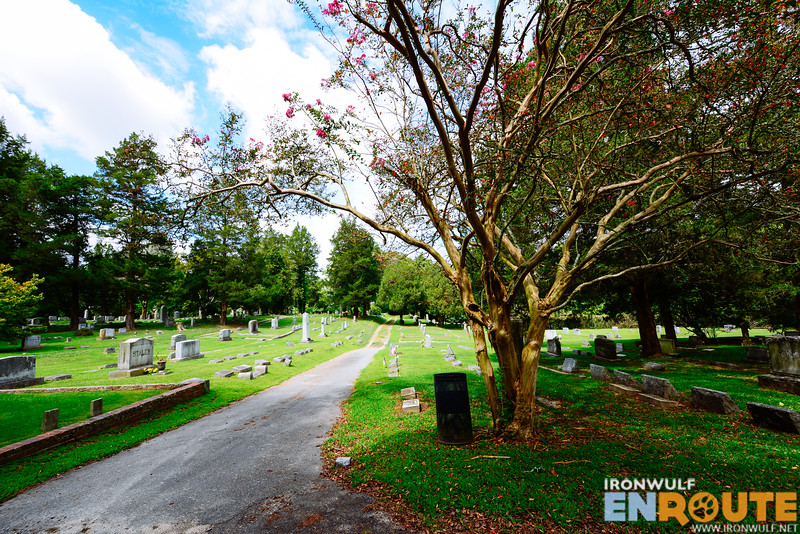
And I found myself running around, apparently lost in this 32-acre hilly terrain dotted with massive cedar trees located inside the Cedar Hill Cemetery in Suffolk, Virginia. I was supposed to accompany my aunt at the grocery in town but I found a map of the cemetery when we visited the nearby Riddick’s Folly House Museum. From the old train station, the famed public cemetery listed in USA’s National Register of Historic Places (NRHP) was just beyond the fence. I’m such a sucker for maps and finding places like solving a mystery case. I asked my aunt to squeeze in a little time before our chore and she gladly obliged. Even for a moment, I was excited to explore the grounds by Nansemond River where Suffolk community began.

Suffolk was Born
It’s easy to dismiss Cedar Hill Cemetery as just another graveyard. A closer look at some of the elaborate Victorian-style grave markers, monuments and an background of Suffolk history would heighten appreciation on this hilly land south of Nansemond River. Looking back briefly, Suffolk history started when Jamestowne, a settlement co-established by English explorer Captain John Smith way back in 1608, north of the James River, was threatened with starvation. Through Captain John Martin, he explored Nansemond River down south following an oyster bed and decided to settle there but conflict with the Nansemond Indian tribe drove them away. The English colonizers in return ransacked their temples. Despite years of conflict, settlers and their community continued to grow and eventually the Indian tribe lost their lands and lives and those who survived left to join another western tribe by 1744.
The land south of James River surrounding Nansemond river was well suited for Tobacco plantation. One of the early settlers, John Constant built a warehouse on the riverfront in 1720 for Tobacco trade. Eventually, a community grew revolving around the warehouse and was called the “Constant’s Wharf”. In 1742, the House of Burgesses, the first legislative assembly of elected representatives in North America, approved a bill to establish the community as a town and named it as “Suffolk” for “Souther Folks”, same name of the hometown of current governor at that time, Sir William Gooch, in England.

The Green Hills Cemetery
In 1802, two and a half acres of land farmed by John Constant and his family was purchased in order to build an Old Union Church also called the Old Meeting House. It was used for community worship and town meetings until 1820 then was moved to Pine Street. The original church cemetery was originally called Green Hills Cemetery.

The Cedar Hills Cemetery
For a Filipino visiting Suffolk, Virginia, it was a challenge to relate to many of its so called heritage without knowing a little about their history. Cedar Hills Cemetery opened up my curiosity on how the city came to be. The cemetery have survived a major fire in Suffolk in 1837 and the War Between States. The cemetery has expanded to more 15,000 grave sites including the original unmarked ones from 1800s. The challenge now for Suffolk people is keeping the heritage alive from vandalism and natural calamities. There were notable personalities buried here from a USA Congressman, to top government officials in Virginia but the local personalities like teachers, a lion trainer, a woodmen add wonderful stories of the people that makes up the town. Fortunately the Nansemond River Garden Club, one of the organizations in helping preserve this heritage spent a lot of their resources to also beautify the grounds.
I only had a little time to inspect each and every significant spots cited from my map but those that I was able to find clearly displays meticulous craftsmanship. Different tombstones also have different stories and unique symbols engraved that has relevant meanings at that time. Like eye-catching Angel at the Obelisk which symbolizes rebirth, protection and resurection. The beautifully carved Darden Monument for the only son Archibald Allen who died at the young age of 20 have acanthus and lilies, thistle and foxglove decorating his tomb. Nearby is Lucy Allen’s tomb with passion flowers and another tomb shaped like a stump is a headstone for an infant, Janet Whitehead Prentis, covered with morning glory, lily of the valley and ferns.
Other significant sites that are easy to find are the unique zinc-made Confederate Monument, erected in 1889, honoring the fellow soldiers with Thomas Washington Smith during the War Between the States and The Watering Fountain, restored in 2007 by the Nansemond River Garden Club, was used to water plants and supply water to work animals. At restoration, a shallow pond was found at the fountain basin believed to be the source for collected rainwater. There are a lot more details to see in Cedar Hill Cemetery that I think it would take me more than half a day to examine every detail I could find or even take a proper photo of each of them. But I’m glad to have visited this solemn resting ground rich in history and culture.
Cedar Hill Cemetery
North Main Street & Constance Road
757.514.4136





Ferdz Decena is an award-winning travel photographer, writer and blogger. His works has found print in publications such as Singapore Airlines’s Silver Kris, Philippine Airlines’ Mabuhay, Cebu Pacific’s Smile and Seair InFlight. He has also lent his expertise to various organizations like the Oceana Philippines, Lopez Group Foundation, Save the Children and World Vision, contributing quality images for their marketing materials.
